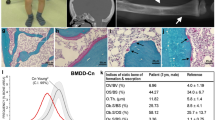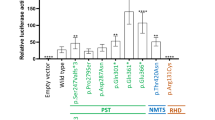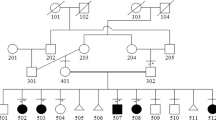Abstract
Cleidocranial dysplasia (CCD) is an autosomal dominant disorder characterized by hypoplastic or absent clavicles, large fontanelles, dental anomalies and delayed skeletal development1. The phenotype is suggestive of a generalized defect in ossification and is one of the most common skeletal dysplasias not associated with disproportionate stature. To date, no genetic determinants of ossficiation have been identified. CCD has been mapped to chromosome 6p212,3, where CBFA1, a gene encoding OSF2/CBFA1, a transcriptional activator of osteoblast differentiation, has been localized4,5. Here, we describe two de novo missense mutations, Met175Arg and Ser191Asn, in the OSF2/CBFA1 gene in two patients with CCD. These two mutations result in substitution of highly conserved amino acids in the DNA-binding domain. DNA-binding studies with the mutant polypeptides show that these amino acid substitutions abolish the DNA-binding ability of OSF2/CBFA1 to its known target sequence. Concurrent studies show that heterozygous nonsense mutations in OSF2/CBFA1 also result in CCD6, while mice homozygous for the osf2/cbfa1 null allele exhibit a more severe lethal phenotype7. Thus, these results together suggest that CCD is produced by haploinsufficiency of OSF2/CBFA1 and provide direct genetic evidence that the phenotype is secondary to an alteration of osteoblast differentiation.
This is a preview of subscription content, access via your institution
Access options
Subscribe to this journal
Receive 12 print issues and online access
$209.00 per year
only $17.42 per issue
Buy this article
- Purchase on Springer Link
- Instant access to full article PDF
Prices may be subject to local taxes which are calculated during checkout
Similar content being viewed by others
References
Jones, K.L. Smith's recognizable patterns of human malformation (W.B. Saunders Company, Philadelphia, 1997).
Gelb, B.D., Cooper, E., Shevell, M. & Desnick, R.J. Genetic mapping of the cleidocranial dysplasia (CCD) locus on chromosome band 6p21 to include a microdeletion. Am. J. Med. Genet. 58, 200–205 (1995).
Mundlos, S. et al. Genetic mapping of cleidocranial dysplasia and evidence of a microdeletion in one family. Hum. Mol. Genet. 4, 71–75 (1995).
Levanon, D. et al. AML1, AML2, and AML3, the human members of the runt domain gene-family: cDNA structure, expression, and chromosomal localization. Genomics 23, 425–32 (1994).
Ducy, P., Zhang, R., Geoffrey, V., Ridall, A.L. & Karsenty, G. Osf 2 Cbfa1: a transcriptional activator of osteoblast differentiation. Cell 89, 747–754 (1997).
Mundlos, S. et al. Mutations involving the transcription factor CBFA1 cause cleidocranial dysplasia. Cell 89, 773–779 (1997).
Otto, F. et al. CBFA1, a candidate gene for the cleidocranial dysplasia syndrome, is essential for osteoblast formation and bone development. Cell 89, 765–771 (1997).
Gergen, J.P. & Wieschaus, E.F. The localized requirements for a gene affecting segmentation in Drosophila: analysis of larvae mosaic for runt. Dev. Biol. 109, 321–335 (1985).
Kania, M.A., Bonner, A.S., Duffy, J.B. & Gergen, J.P., The Drosophila segmentation gene runt encodes a novel nuclear regulatory protein that is also expressed in the developing nervous system. Genes Dev. 4, 1701–1713 (1990).
Tsai, C. & Gergen, J.P. Gap gene properties of the pair-rule gene runt during Drosophila segmentation. Development. 120 1671–1683 (1994).
Kagoshima, H. et al. The Runt domain identifies a new family of heteromeric transcriptional regulators. Trends Genet. 9, 338–341 (1993).
Okuda, T. van Deursen, J., Hiebert, S.W., Grosveld, G. & Downing, J.R. AML1, the target of multiple chromosomal translocations in human leukemia, is essential for normal fetal liver hematopoiesis. Cell 84, 321–330 (1996).
Ahn, M.Y., Bae, S.C., Maruyama, M. & Ito, Y. Comparison of the human genomic structure of the Runt domain-encoding PEBP2/CBFalpha gene family. Gene 168, 279–280 (1996).
loannou, P.A. et al. A new bacteriophage P1-derived vector for the propagation of large human DNA fragments. Nat. Genet. 6, 84–89 (1994).
Ducy, P. & Karsenty, G. Two distinct osteoblast-specific cis-acting elements control expression of a mouse osteocalcin gene. Mol. Cell. Biol. 15, 1858–1869 (1995).
Kingsley, D.M. et al. The mouse short ear skeletal morphogenesis locus is associated with defects in a bone morphogenetic member of the TGF beta superfamily. Cell 171, 399–410 (1992).
Kingsley, D.M. What do BMPs do in mammals?Clues from the mouse short-ear mutation. Trends Genet. 10, 16–21 (1994).
Storm, E.E. et al. Limb alterations in brachypodism brachypodism mice due to mutations in a new member of the TGFβ-superfamily. Nature 368, 639–643 (1994).
Francomano, C.A., Mclntosh, I. & Wilkin, D.J. Bone dysplasias in man* molecular insights. Curr. Opin. Genet Dev. 6, 301–308 (1996).
Rousseau, F. et al. Mutations of the fibroblast growth factor receptor-3 gene in achondroplasia. Horm. Res. 45, 108–110 (1996).
Zakany, J. & Duboule, D. Synpolydactyly in mice with a targeted deficiency in the HoxD complex. Nature 384, 69–71 (1996).
Muragaki, Y., Mundlos, S., Upton, J. & Olsen, B.R. Altered growth and branching patterns in synpolydactyly caused by mutations in HOXD13. Science 272, 548–551 (1996).
Wagner, T. et al. Autosomal sex reversal and campomelic dysplasia are caused by mutations in and around the SRY-related gene SOX9. Cell 79, 1111–1120 (1994).
Foster, J.W. et al. Campomelic dysplasia and autosomal sex reversal caused by mutations in an SRY-related gene. Nature 372, 525–530 (1994).
Karaplis, A.C. et al. Lethal skeletal dysplasia from targeted disruption of the parathyroid hormone-related peptide gene. Genes Dev. 8, 277–289 (1994).
Grigoriadis, A.E. et al. c-Fos: a key regulator of osteoclast-macrophage lineage determination and bone remodeling. Science 266, 443–448 (1994).
Ausubel, F.M. et al. Current Protocols in Molecular Biology John Wiley & Sons, New York, (1994).
Innis, M.A., Gelfand, D.H., Sninsky, J.J. & White, T.J. PCR Protocols, a Guide to Methods and Applications. Academic. Press, San Diego, CA, (1990).
Baldini, A. & Lindsay, E.A. Mapping human YAC clones by fluorescence in situ hybridization using Alu-PCR from single yeast colonies. in In Situ Hybridization Protocols, Vol 33 (ed. Choo, K.H.A.) 75–85 Human Press, Clifton, NJ, (1994).
DeMarchi, J.M., Richards, C.S., Fenwick, R.G., Pace, R. & Beaudet, A.L. A robotics-assisted procedure for large scale cystic fibrosis mutation analysis. Hum. Mutat. 4, 281–290 (1994).
Author information
Authors and Affiliations
Corresponding author
Rights and permissions
About this article
Cite this article
Lee, B., Thirunavukkarasu, K., Zhou, L. et al. Missense mutations abolishing DNA binding of the osteoblast-specific transcription factor OSF2/CBFA1 in cleidocranial dysplasia. Nat Genet 16, 307–310 (1997). https://doi.org/10.1038/ng0797-307
Received:
Accepted:
Issue Date:
DOI: https://doi.org/10.1038/ng0797-307



